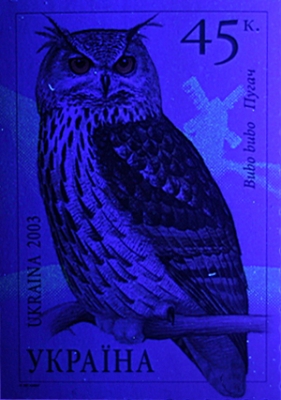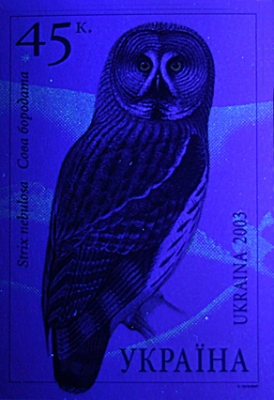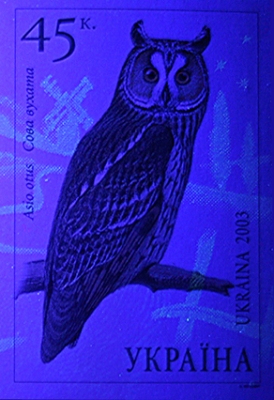-
Owls of Ukraine
Ukraine 2003.06.14
In issue: Sheet(s): 1
Issued in: sheets of 12 stamps
-
Number by catalogue: Michel: 574-585 Yvert: 515-526 Scott: 513
Perforation type: 11 ½x11 ½
Subject:
On 12 stamps are represented different kinds of the owls living in territory of Ukraine
Topics: Mills within the landscapes Windmills
-
Number by catalogue: Michel: 574 Yvert: 515 Scott: 513a
Perforation type: 11 ½x11 ½
Subject:
45 kopiyok. Eurasian Eagle Owl, Bubo bubo*. Under UF exposition the windmill appears on the right
Additional:
*The Eagle Owl is a large and powerful bird, smaller than the Golden Eagle but larger than the Snowy Owl. It has a wingspan of up to 138-200 cm (55-79 in) and measures 58-75 cm (23-30 in) long. Females weigh 1.75-4.2 kg (3.9-9.4 lbs) and males weigh 1.5-3.2 kg (3.3-7 lbs). In comparison, the common Barn Owl weighs about 500 grams (1.1 lbs). It mainly feeds on small mammals, but can kill prey up to the size of foxes and young deer (up to 10 kg/22 lb), if taken by surprise. Larger prey (over 3 kg/7 lb) is consumed on the ground which leaves the bird vulnerable (for example to foxes).
Topics: Mills within the landscapes Windmills
-
Number by catalogue: Michel: 577 Yvert: 518 Scott: 513d
Perforation type: 11 ½x11 ½
Subject:
45 kopiyok. The Great Grey Owl or Lapland Owl, Strix nebulosa*. Under UF exposition the windmill appears on the right
Additional:
*The Great Grey Owl or Lapland Owl (Strix nebulosa) is a very large owl, distributed across the Northern Hemisphere.
Adults have a big, rounded head with a grey face and yellow eyes with darker circles around them. The underparts are light with dark streaks; the upper parts are grey with pale bars. This owl does not have ear tufts and has the largest facial disc of any raptor.
In terms of length, the Great Grey Owl rivals the Eurasian Eagle Owl and the Blakiston's Fish Owl as the world's largest owl. However, much of its size is deceptive, since this species' fluffy feathers, long tail and large head obscure a body lighter than that of most other large owls. The length ranges from 61 to 84 cm (24 to 33 in), averaging 72 cm (27 in) for females and 67 cm (26 in) for males. The wingspan can exceed 152 cm (60 in), but averages 142 cm (56 in) for females and 140 cm (55 in) for males. The adult weight ranges from 700 to 1800 grams (1½ to 4 lb), averaging 1290 grams (2 lb 14 oz) for females and 1000 g (2 lb 3 oz) for males. The males are usually smaller than females, as in most owl species.
Topics: Mills within the landscapes Windmills
-
Number by catalogue: Michel: 583 Yvert: 524 Scott: 513j
Perforation type: 11 ½x11 ½
Subject:
45 kopoyok. The Long-eared Owl, Asio otus*. Under UF exposition the windmill appears on the left
Additional:
*The Long-eared Owl (Asio otus) is a species of owl which breeds in Europe, Asia, and North America. This species is a part of the larger grouping of owls known as typical owls, family Strigidae, which contains most species of owl. The other grouping of owls are the barn owls, family Tytonidae.
The Long-eared Owl is a medium sized owl, 31-37 cm in length with an 86-98 cm wingspan. It has erect blackish ear-tufts, which are positioned in the center of the head. The female is larger in size and darker in colouration than the male. The Long-eared Owl’s brownish feathers are vertically streaked. Tarsus and toes are entirely feathered. Eye disks are also characteristic in this species. However, the eye disks of A. otus are darker in color or rusty-orange. This nocturnal species is perhaps most easily seen perched in a tree in its daytime roost.
The Long-eared Owl's breeding season is from February to July. This bird is partially migratory, moving south in winter from the northern parts of its temperate range. Its habitat is forest close to open country.
It nests in trees, often coniferous, using the old stick nests of other birds such as crows, ravens and magpies and various hawks. The average clutch size is 4-6 eggs, and the incubation time averages from 25-30 days. It will readily use artificial nesting baskets. An unusual characteristic of this species is its communal nesting in thickets during the winter months.
The Long-eared Owl hunts over open country by night. It is very long winged, like the similar Short-eared Owl, and glides slowly on stiff wings when hunting. Its food is mainly rodents, small mammals, and birds.Topics: Mills within the landscapes Windmills




2003-s-1-logo.jpg)

2003-s-2-logo.jpg)

2003-s-3-logo.jpg)
